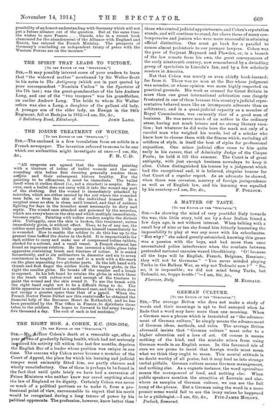THE IODINE TREATMENT OF WOUNDS.
[TO TEE EDITOR OF THE "SPECTATOR."]
Six,--The enclosed is a free translation from an article in a French newspaper. The invention referred to seems to be one which our authorities might investigate at once.—I am, Sir,
"All surgeons are agreed that the immediate painting with a tincture of iodine of bullet wounds and the sur- rounding skin before first dressing generally renders them aseptic and their subsequent history healthy. For the painting to be efficacious, it must be immediate. The bullet itself when it strikes direct (i.e., not a ricochet) is aseptic. More- over, such a bullet does not carry with it into the wound any part of the clothing. But the wound is immediately attacked by microbes, which are either carried by the soil where the wounded man falls, or from the skin of the individual himself. In a surgical sense no skin is clean until treated, and that of soldiers fighting for days in the trenches must necessarily be dirty and septic. The wound once attacked and poisoned by the microbes, which are everywhere on the skin and which multiply immediately, becomes septic. Painting with iodine renders aseptic the dirtiest skin. Unhappily, once the skin is broken, this treatment, unless immediately given, is without effect. Thus, to be of any use, the soldier must perform this little operation himself immediately he is wounded. How to enable the soldier to do this has up to the present time baffled the doctor in the field. It is impracticable for each soldier to carry and make use of compressed iodine tablets, Alcohol for a solvent, and a small vessel. A French chemist has found an ingenious solution. He has invented a little glass tube apparatus containing brush and tincture of iodine. It is sealed hermetically, and is six millimetres in diameter and six to seven centimetres in length. Near one end is a neck with a file-mark on the glass separating two globular parts. In the left hand with thumb and first finger the soldier holds the larger globe, in the right the smaller globe. He breaks off the smaller and a brush is exposed. In his left hand he retains the globe.in which there is the brush with cotton-wool and enough of the tincture to paint the wound and the skin round it. To ute the brush with the right hand ought not to be a difficult thing to do. The little apparatus is enclosed in a cardboard case, and the whole does not occupy a greater space than that of a pgncil. When the French Doctor Pierre Bethel saw this contrivante he obtained the financial help of the Baroness Henri de Rothschild, and he has been permitted by the War Office in France:to distribute these tubes to the soldiers. He hopes to forward to thst army twenty- five thousand a day. The cost of each is text centinies."






































 Previous page
Previous page